
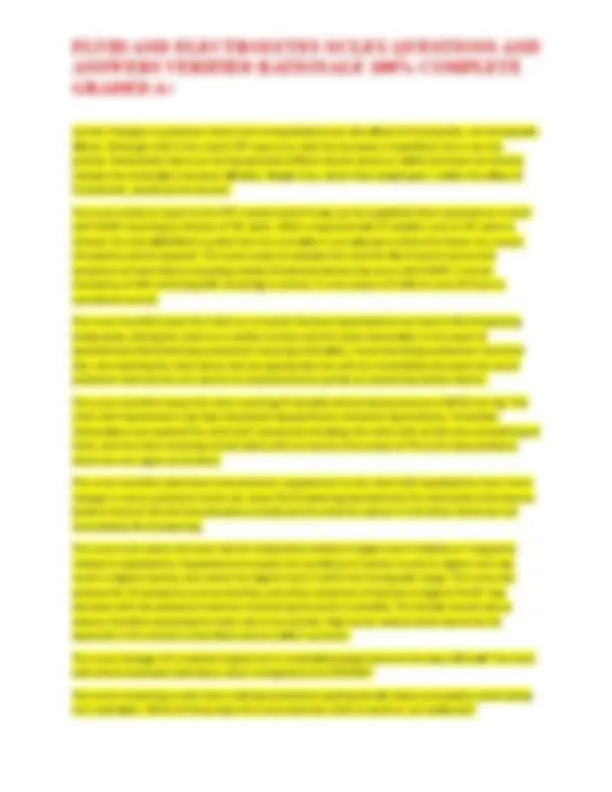
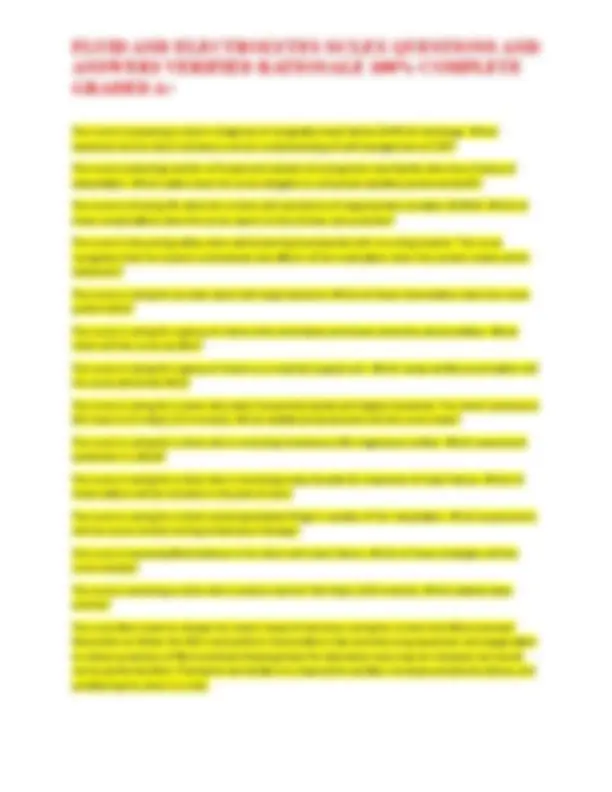
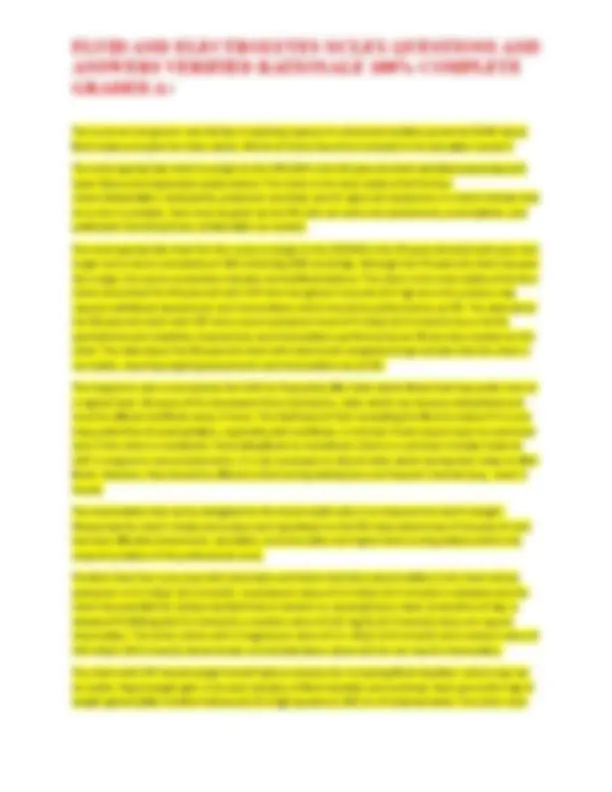
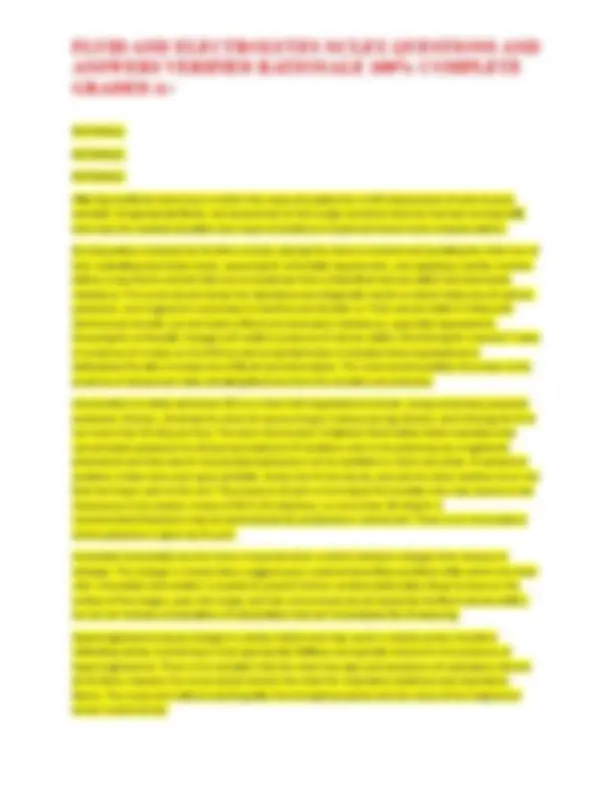
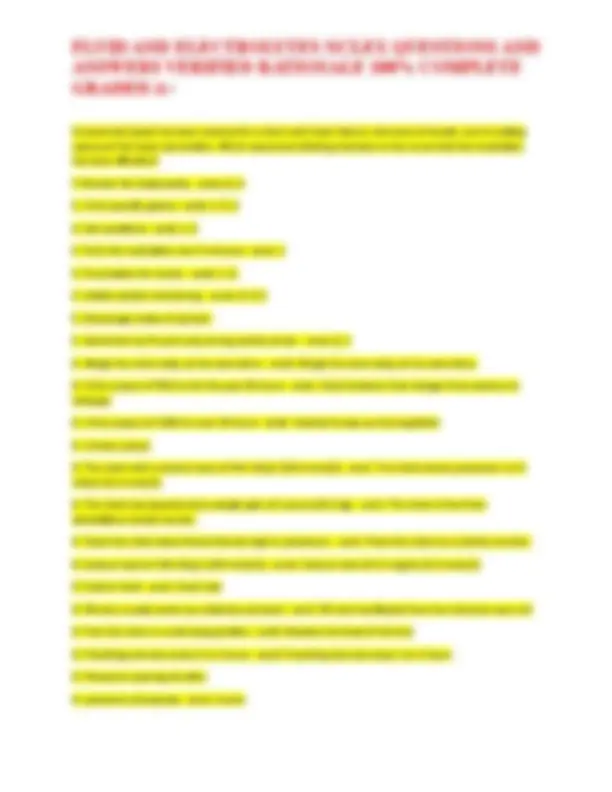
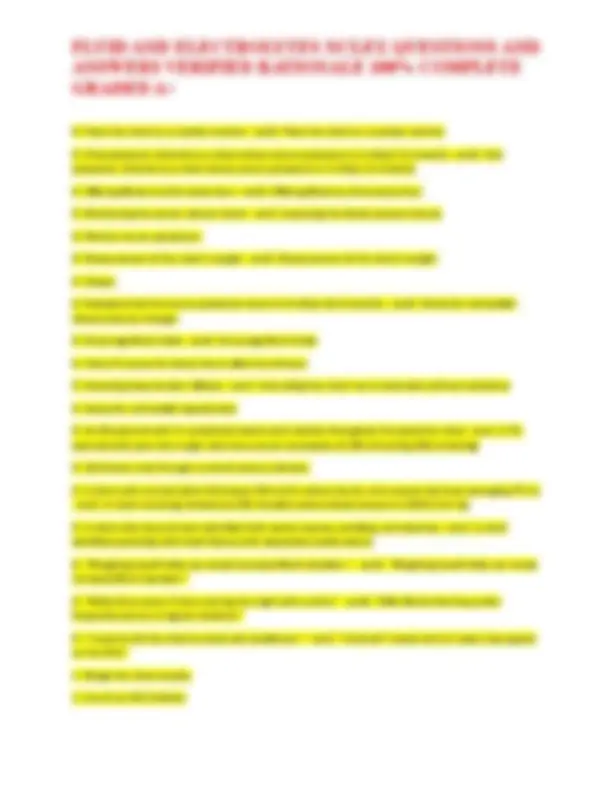
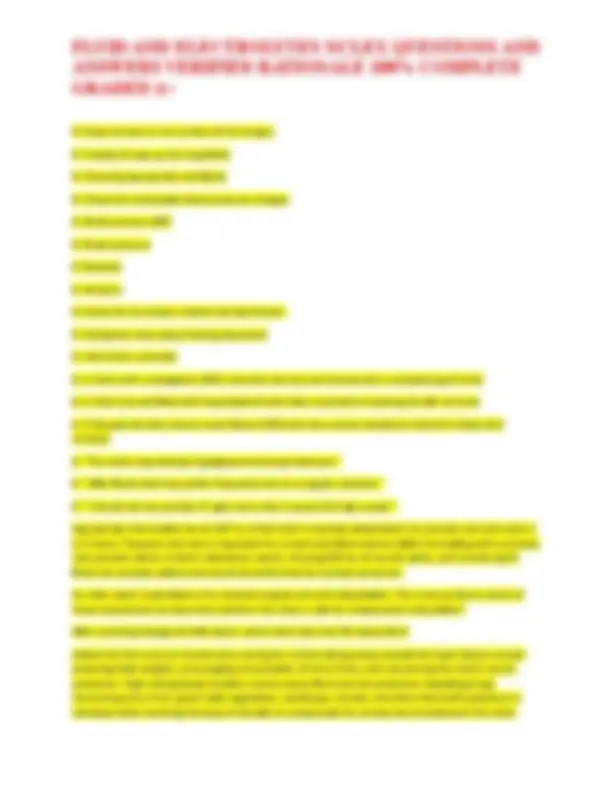
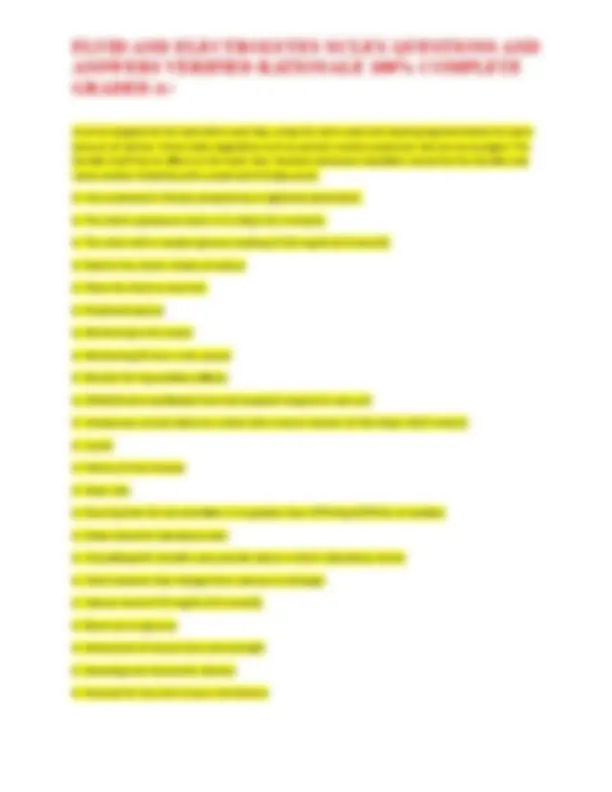
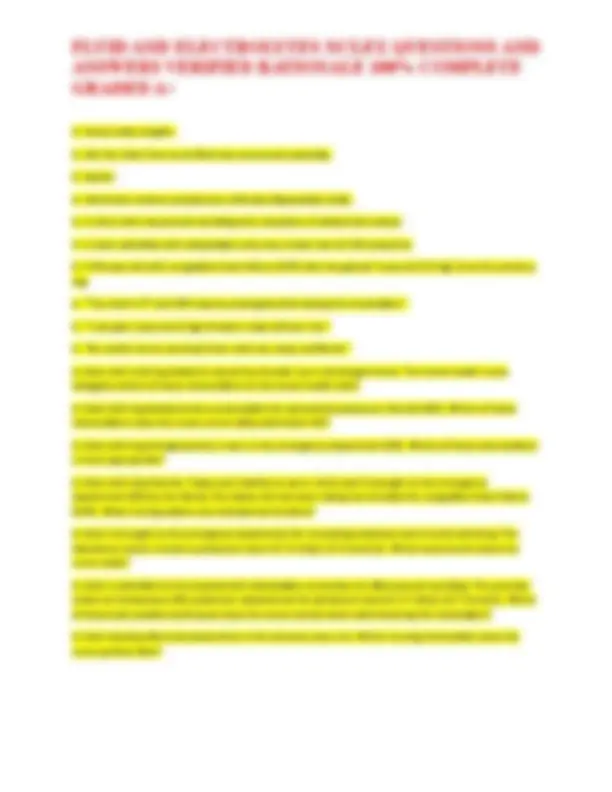




Study with the several resources on Docsity

Earn points by helping other students or get them with a premium plan


Prepare for your exams
Study with the several resources on Docsity

Earn points to download
Earn points by helping other students or get them with a premium plan
Community
Ask the community for help and clear up your study doubts
Discover the best universities in your country according to Docsity users
Free resources
Download our free guides on studying techniques, anxiety management strategies, and thesis advice from Docsity tutors
FLUID AND ELECTROLYTES NCLEX QUESTIONS AND ANSWERS VERIFIED RATIONALE 100% COMPLETE GRADED A+.pdf
Typology: Exams
1 / 19

This page cannot be seen from the preview
Don't miss anything!












While taking a potassium-sparing diuretic, the nurse teaches the client to avoid bananas, ACE inhibitors, and salt substitutes. Other foods high in potassium include cantaloupe, kiwi, oranges, avocados, broccoli, dried beans, lima beans, mushrooms, potatoes, seaweed, soybeans, and spinach. Salt substitutes contain potassium and may predispose the client to hyperkalemia.Apples and grapes are considered lower potassium-containing foods. Which client is most appropriate for the nurse manager of the medical-surgical unit to assign to the LPN/LVN? When caring for an older adult with hypernatremia, the nurse first encourages the client to take more fluid. Encouraging fluids in the older adult is important to prevent dehydration with resulting concentrated sodium levels.Hypernatremia and fluid loss typically occur in tandem in the older adult. Restricting sodium does not replace fluids needed by many elderly clients. A diuretic will worsen the fluid volume deficit the client is experiencing. Monitoring the osmolarity will detect an abnormality, but not resolve the problem. When caring for an ED client with an elevated potassium level, the nurse needs to assess the client for any use of salt substitutes, any use of ACE inhibitors or potassium-sparing diuretics, as well as kidney disease.History of liver disease does not increase the client's potassium level. Insulin, which moves potassium into the cell, can be used as a treatment for hyperkalemia, in addition to diabetes. Taking insulin would lower the potassium level. When caring an older adult admitted for dehydration, the nurse determines if the client is safe for independent ambulation by assessing for orthostatic blood pressure. Blood pressure measured with the client lying, then sitting, and finally standing is done to detect orthostatic or postural changes. During low blood volume states, especially when standing, insufficient blood flow to the brain may cause hypotension and tachycardia upon arising. This may cause light-headedness and dizziness, which increases the risk for falls, especially in older adults.Assessment of oral mucous membranes and the pulse rate can detect symptoms of dehydration, but these are not the best ways to assess for a fall risk. Checking serum potassium does ensure safety for ambulation nor assess for fall risk. When assessing fluid balance on a client with heart failure the nurse must weigh the client at the same time every day. Changes in daily weights are the best indicators of fluid losses or gains. A weight change of 1 pound (0.5 kg) corresponds to a fluid volume change of about 500 mL therefore the weight must be compared to intake and output.The nurse must weigh the client rather than rely on client estimate or memory. An indwelling catheter poses a risk for catheter associated urinary tract infection, and is reserved for specific reasons. Auscultating for adventitious lung sounds or crackles will demonstrate fluid overload, but may not immediately show up. The two most important areas to monitor during rehydration are pulse rate and quality and urine output. In addition, decreasing specific gravity of urine is also an indication of rehydration. Blood pressure is another important vital sign to monitor during rehydration.Blood glucose changes do not have a direct relation to a client's hydration status; lactated ringers are free from glucose.
The step down unit receives a new admission who has uncontrolled diabetes, polyuria, and a blood pressure of 86/46 mm Hg. Which staff member is assigned to care for her? The RN who has floated from the intensive care unit needs to care for this clinically unstable woman with uncontrolled diabetes. The clinical manifestations suggest that the client is experiencing hypovolemia and possible hypovolemic shock from osmotic diuresis. The RN from the intensive care unit will have extensive experience caring for clients with hypovolemia, hyperglycemia, and fluid volume deficit/shock.The LPN/LVN who has floated from the long-term care unit or who frequently administers medications to multiple clients will not be as familiar with care for critically ill clients, or qualified to care for this clinically unstable client. Although the resource on diabetes is helpful, the RN who works as a diabetes educator will not be as familiar with care for acutely or critically ill clients. The RN is caring for a client who is severely dehydrated. Which nursing action can be delegated to the unlicensed assistive personnel (UAP)? The RN is assessing a 70-year-old client admitted to the unit with severe dehydration. Which finding requires immediate intervention by the nurse? The rapid response team (RRT) is called to the bedside of a client with heart rate of 38 beats per minute and a potassium level of 7.0 mEq/L (7.0 mmol/L). For which medication will the nurse anticipate a prescription? The rapid response nurse expects to administer a combination of 20 units of regular insulin in 100 mL of 20% dextrose in water. This may be prescribed to promote movement of potassium from the blood into the intracellular fluid.While atropine will treat bradycardia, it does not address the underlying cause of bradycardia which is likely hyperkalemia. Sodium polystyrene sulfonate (Kayexalate)may be used for hyperkalemia, but it will not act quickly enough in an emergency. Additional potassium such as contained in potassium phosphate will make the client's condition more critical. The primary care provider writes prescriptions for a client who is admitted with a serum potassium level of 6.9 mEq/L (6.9 mmol/L). What does the nurse implement first? The nursing student understands the side effects of Bumex when commenting that inverted T waves and a U wave may appear on the EKG. Hypokalemia may cause depressed ST segments, flat or inverted T waves or the presence of a U wave on the ECG as well as dysrhythmias. High-ceiling (loop) diuretics, such as furosemide (Lasix, furosemide), promote loss of water, sodium, and potassium.PT and INR are typically prolonged with therapy with warfarin (Coumadin) or individuals with liver disease. Hypoglycemia may occur with oral hypoglycemic medications or insulin. Salt substitutes are typically avoided when the client has hyperkalemia or is taking an ACE inhibitor because many substitutes contain potassium chloride. The nurse recognizes that Furosemide is effective when the client is free from adventitious breath sounds such as crackles. Other positive outcomes to the diuretic include normal heart rate, weight loss with resolution of edema, and increased urine output.A potassium value of 5.1 mEq/L or (5.1 mmol/L) is
The nurse is preparing a client a diagnosis of congestive heart failure (CHF) for discharge. Which statement by the client indicates a correct understanding of self-management of CHF? The nurse is planning care for a 72-year-old resident of a long-term care facility who has a history of dehydration. Which action does the nurse delegate to unlicensed assistive personnel (UAP)? The nurse is infusing 3% saline for a client with syndrome of inappropriate secretion (SIADH). Which of these complications does the nurse report to the primary care provider? The nurse is discussing safety when administering bumetanide with a nursing student. The nurse recognizes that the student understands side effects of this medication when the student makes which statement? The nurse is caring for an older adult with hypernatremia. Which of these interventions does the nurse perform first? The nurse is caring for a group of clients with electrolytes and blood chemistry abnormalities. Which client will the nurse see first? The nurse is caring for a group of clients on a medical surgical unit. Which newly written prescription will the nurse administer first? The nurse is caring for a client who takes furosemide (Lasix) and digoxin (Lanoxin). The client's potassium (K+) level is 2.5 mEq/L (2.5 mmol/L). Which additional assessment will the nurse make? The nurse is caring for a client who is receiving intravenous (IV) magnesium sulfate. Which assessment parameter is critical? The nurse is caring for a client who is receiving a loop diuretic for treatment of heart failure. Which of these actions will be included in the plan of care? The nurse is caring for a client receiving lactated Ringer's solution IV for rehydration. Which assessments will the nurse monitor during intravenous therapy? The nurse is assessing fluid balance in the client with heart failure. Which of these strategies will the nurse employ? The nurse is assessing a client with a sodium level of 118 mEq/L (118 mmol/L). Which activity takes priority? The nurse first needs to elevate the client's head of bed when caring for a client with fluid overload. Remember to follow the ABC's and perform interventions that promote lung expansion and oxygenation to relieve symptoms of fluid overload.Drawing blood for laboratory tests may be indicated, but would not be performed first. Placing the extremities in a dependent position increases peripheral edema, and positioning the client in a side-
The nurse at a long-term care facility is teaching a group of unlicensed assistive personnel (UAP) about fluid intake principles for older adults. Which of these should be included in the education session? The most appropriate client to assign to the LPN/LVN is the 64-year-old client admitted yesterday with heart failure and dependent pedal edema. This client is the most stable of all the four clients.Dehydration, tachycardia, potassium overload, and GI signs and symptoms in a client indicate that he or she is unstable. Care must be given by the RN who can carry out assessments, prescriptions, and participate interdisciplinary collaboration as needed. The most appropriate client for the nurse to assign to the LPV/LVN is the 76-year-old adult with poor skin turgor and a serum osmolarity of 300 mOsm/kg (300 mmol/kg). Although the 76-year-old client has poor skin turgor, the serum osmolarity indicates normal fluid balance. This client is the most stable of the four clients described.The 44-year-old with CHF who has gained 3 pounds (1.4 kg) since the previous day requires additional assessments and interventions which should be performed by an RN. The data about the 58-year-old client with CRF and a serum potassium level of 6 mEq/L (6.0 mmol/L) has a risk for dysrhythmia and instability. Assessments and interventions performed by an RN are also needed on this client. The data about the 80-year-old client with edema and congested lungs indicate that the client is not stable, requiring ongoing assessments and interventions by an RN. The long-term care nurse teaches the UAPs to frequently offer older adults fluids that they prefer and on a regular basis. Because of the decreased thirst mechanism, older adults can become dehydrated and must be offered oral fluids every 2 hours. The likelihood of their accepting the fluid increases if it is one they prefer.Risk of overhydration, especially with oral fluids, is minimal. Fluids would never be restricted even if the client is incontinent. Restricting fluids to incontinent clients is a common mistake made by UAP in long-term care environments. It is not necessary to disturb older adults during their sleep to offer fluids. However, they should be offered a drink during waking hours at frequent intervals (e.g., every 2 hours). The intervention that can be delegated to the home health aide is to measure the client's weight. Measuring the client's intake and output and reporting it to the RN helps determines if the plan of care has been effective.Assessment, education, and instruction are higher-level nursing actions within the scope of practice of the professional nurse. The first client the nurse sees with electrolyte and blood chemistry abnormalities is the client whose potassium is 6.2 mEq/L (6.2 mmol/L). A potassium value of 6.2 mEq/L (6.2 mmol/L) is elevated and the client has potential for cardiac dysrhythmias.A random or casual glucose, taken at any time of day, is elevated if ≥200mg/dL(>11.1mmol/L); a random value of 123 mg/dL (6.9 mmol/L) does not require intervention. The other clients with a magnesium value of 2.1 mEq/L (1.0 mmol/L) and a sodium value of 143 mEq/L (143 mmol/L) demonstrate normal laboratory values and do not require intervention. The client with CHF should weigh himself daily to observe for increasing fluid retention, which may not be visible. Rapid weight gain is the best indicator of fluid retention and overload. Each pound (0.5 kg) of weight gained (after the first half-pound [0.2 kg]) equates to 500 mL of retained water. The client must
Offering oral fluids every hour is within the scope of practice for a UAP.Assessments of oral mucosa, selection of appropriate fluids, and assessment of skin turgor would be done by licensed nursing staff, who have the needed education and scope of practice to implement these more complex actions. Nursing actions indicated at this time include: placing the client on bedrest and assisting the client out of bed, evaluating electrolyte levels, assessing for orthostatic hypotension, and applying a cardiac monitor. Safety is required to prevent falls due to weakness from a likely fluid volume deficit and electrolyte imbalance. The nurse should review the laboratory and diagnostic results to detect likely loss of sodium, potassium, and magnesium secondary to diarrhea and diuretic us. Fluid volume deficit is likely with diarrhea and diuretic use and leads to fluid and electrolyte imbalances, especially hypokalemia. Assessing for orthostatic changes will confirm presence of volume deficit. Monitoring for inverted T wave or presence of U wave on the ECG as well as dysrhythmias is indicated when hypokalemia is anticipated.Diuretics increase loss of fluids and electrolytes. The nurse would question this order in the presence of assessment data indicating fluid loss from the diuretics and diarrhea. Interventions to safely administer KCl to a client with hypokalemia include: using a pharmacy prepared potassium infusion, checking the client for any burning or redness during infusion, and infusing the IV at not more than 10 mEq per hour. The Joint Commission's National Client Safety Goals mandates that concentrated potassium be diluted and added to IV solutions only in the pharmacy by a registered pharmacist and that vials of concentrated potassium not be available in client care areas. IV potassium solutions irritate veins and cause phlebitis. Assess the IV site hourly, and ask the client whether he or she feels burning or pain at the site. The presence of pain or burning at the insertion site may require a new intravenous to be started. A dose of KCl 5-10 mEq/hour, no more than 20 mEq/hr is recommended.Potassium may be administered by peripheral or central vein. There is no circumstance where potassium is given by IV push. Immediate intervention by the nurse is required when a client's behavior changes from anxious to lethargic. This change in mental status suggests poor cerebral blood flow and fluid shifts within the brain cells. Immediate intervention is needed to prevent further cerebral dysfunction.Deep furrows on the surface of the tongue, poor skin turgor, and low urine output are all caused by the fluid volume deficit, but do not indicate complications of dehydration that are immediately life-threatening. Hypermagnesemia causes changes in cardiac rhythm and may result in cardiac arrest, therefore instituting cardiac monitoring is most appropriate.Reflexes are typically reduced in the presence of hypermagnesemia. There is no indication that the client has signs and symptoms of respiratory distress at this time, however the nurse would monitor the client for respiratory weakness and respiratory failure. The nurse will institute teaching after the emergency passes and the cause of the magnesium excess is determined.
D. Place the client on a cardiac monitor - ansD. Place the client on a cardiac monitor D. Oral potassium chloride to a client whose serum potassium is 3 mEq/L (3 mmol/L) - ansD. Oral potassium chloride to a client whose serum potassium is 3 mEq/L (3 mmol/L) D. Offering fluids to drink every hour - ansD. Offering fluids to drink every hour D. Monitoring the serum calcium levels - ansC. Assessing the blood pressure hourly D. Monitor serum potassium. D. Measurement of the client's weight - ansD. Measurement of the client's weight D. Grapes D. Evaluates that the serum potassium level is 4.0 mEq/L (4.0 mmol/L) - ansB. Checks for orthostatic blood pressure changes D. Encourage fluid intake - ansD. Encourage fluid intake D. Check IV access for blood return after the infusion D. Assessing deep tendon reflexes - ansC. Instructing the client not to ambulate without assistance D. Assess for orthostatic hypotension D. An 80-year-old with 3+ peripheral edema and crackles throughout the posterior chest - ansC. A 76- year-old with poor skin turgor who has a serum osmolarity of 300 mOsm/kg (300 mmol/kg) D. Administer only through a central venous catheter. D. A client with normal saline infusing at 150 mL/hr whose hourly urine output has been averaging 75 mL
C. Use an IV pump to deliver the medication C. The client whose potassium is 6.2 mEq/L (6.2 mmol/L) C. The client is free from adventitious breath sounds. C. Sodium polystyrene sulfonate (Kayexalate) C. Serum osmolarity of 294 mOsm/kg C. RN who has floated from the intensive care unit C. Pulse rate and quality C. Potassium level of 6.0 mEq/L (6.0 mmol/L) C. Poor skin turgor with tenting remaining for 2 minutes after the skin is pinched C. Places the extremities in a dependent position C. Place the client on a cardiac monitor. C. Oral phosphorus supplements to a client with acute hypophosphatemia C. Notes pulse rate is 72 beats/min and bounding C. Monitoring skin turgor for tenting C. Monitoring IV fluid to maintain the drip rate at 75 mL/hr C. Monitor the serum osmolarity C. Instruction on the proper use of drugs C. Instructing the client not to ambulate without assistance C. Institute teaching on avoiding magnesium rich foods C. Infuse at a rate of no more than 10 mEq per hour. C. Increases in edema C. Auscultate the lungs for adventitious sounds. C. Assessing the blood pressure hourly C. Administer the ordered diuretic. C. ACE inhibitors C. A client receiving intravenous (IV) diuretics whose blood pressure is 88/52 mm Hg
B. Deep furrows on the surface of the tongue B. Crackles ½ way up the lung fields B. Choosing appropriate oral fluids B. Checks for orthostatic blood pressure changes B. Blood pressure (BP) B. Blood pressure B. Bananas B. atropine B. Assess for burning or redness during infusion. B. Asking the client about feeling depressed B. Administer a diuretic B. A client with a nasogastric (NG) tube who has dry oral mucosa and is complaining of thirst B. A client just admitted with hyperkalemia who takes a potassium-sparing diuretic at home B. A 58-year-old with chronic renal failure (CRF) who has a serum potassium level of 6 mEq/L (6. mmol/L) B. "The client may develop hypoglycemia during treatment." B. "Offer fluids that they prefer frequently and on a regular schedule." B. "I should call my provider if I gain more than 1 pound (0.5 kg) a week." Appropriate intervention by an UAP to a client who is severely dehydrated is to provide oral care every 1 to 2 hours. Frequent oral care is important for a client with fluid volume deficit.Consulting with a primary care provider about a client's laboratory results, infusing 500 mL of normal saline, and monitoring IV fluids are complex actions and would be performed by licensed personnel. An older adult is admitted to the medical surgical unit with dehydration. The nurse performs which of these assessments to determine whether the client is safe for independent ambulation? After receiving change-of-shift report, which client does the RN assess first? Actions for the nurse to include when caring for a client taking a loop diuretic for heart failure include: assessing daily weights, encouraging consumption of citrus fruits, and monitoring the client's serum potassium. High-ceiling (loop) diuretics remove excess fluid and are potassium-depleting drugs. Consuming citrus fruit, green leafy vegetables, cantaloupe, tomato, and other food with potassium is indicated while receiving this type of diuretic to compensate for urinary loss of potassium.The client
must be weighed at the same time each day, using the same scale and wearing approximately the same amount of clothes. Green leafy vegetables such as spinach contain potassium and are encouraged. The diuretic itself has no effect on the heart rate, however potassium depletion caused by the diuretic may cause cardiac irritability with a weak and thready pulse. A. Use a potassium infusion prepared by a registered pharmacist. A. The client's potassium level is 5.1 mEq/L (5.1 mmol/L). A. The client with a random glucose reading of 123 mg/dL (6.8 mmol/L) A. Restrict the client's intake of sodium A. Place the client on bed rest. A. Peripheral edema A. Monitoring urine output A. Monitoring 24-hour urine output A. Monitor for hyperactive reflexes A. LPN/LVN who has floated from the hospital's long-term care unit A. Intravenous normal saline to a client with a serum sodium of 132 mEq/L (132 mmol/L) A. Insulin A. History of liver disease A. Heart rate A. Ensuring that the concentration is no greater than 1?9?mEq/10?9?mL of solution A. Draws blood for laboratory tests A. Consulting with a health care provider about a client's laboratory results A. Client behavior that changes from anxious to lethargic A. Calcium level of 9.5 mg/dL (2.4 mmol/L) A. Blood serum glucose A. Assessment of muscle tone and strength A. Assessing oral mucosa for dryness A. Assesses for dry oral mucous membranes